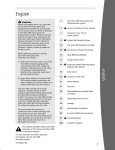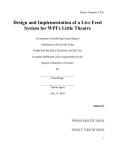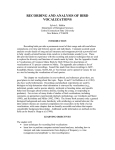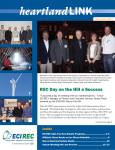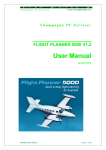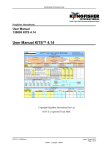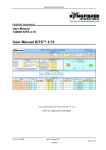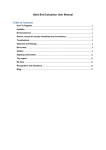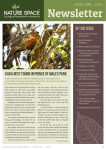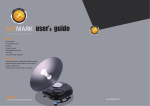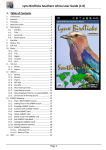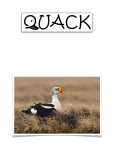Download Vol.3 No.1 - BirdLife Northern Queensland?
Transcript
Contact call Newsletter of Birdlife Northern Queensland Volume 3 Number 1 March 2014 An unusual visitor:Yellow-billed Kingfisher On the 28th December 2013 a female Yellow-billed Kingfisher was seen along Bushy Creek at Kingfisher Park Birdwatchers Lodge by Vena Beetson who was a guest at the Lodge. The kingfisher was subsequently photographed by Hiroshi and Miho Hashimoto, also guests at the Lodge, which confirmed the sighting as a female Yellow-billed Kingfisher. A further search on the 29th did not sight the bird, but it was heard calling in rainforest, adjacent to Bushy Creek by four observers experience with its call, early in the morning. The normally accepted range of this species in Australia is from Cape York Peninsula, south to Weipa on the west coast across the cape to the southern extent of the McIlwraith Range near Silver Plains Station, just south-east of Coen (HANZAB 1999). This record represents an extension of range of about 360km. We speculate that it is possible that this bird followed the river systems from the west coast of Cape York, along the Mitchell River, into Rifle Creek and then Bushy Creek. Del Richards from Fine Feather Tours says there has been at least five reports of this species south of their normal range but none of them have supporting evidence, which makes this record important. Thanks to Del Richards for his input and to Hiroshi and Miho Hashimoto for allowing us to use their image of the Yellow-billed Kingfisher. Keith & Lindsay Fisher. Kingfisher Park Birdwatchers Lodge. Newsletter Contents 1. Yellow-billed kingfisher sighting 2. From the Convenor 3. AGM Notice, Introducing our new website 4. Mission Beach PIP count 2013 5. Saving the nutmeg pigeon - Margaret Thorsbourne AO 6. A guide to binocular care 7. Kingfisher Park Australia Day weekend trip report 8. Birding in splendid isolation: Cape York Peninsula 9. Cumberland Dam, Georgetown 10. Identifying Grey Falcons 11. Databases, listing and challenges. The new Eremaea eBird 12. Monitoring Lovely Fairy-wrens on Redden Island 13. Notice Board 14. Activities calendar Birdlife Northern Queensland From the Convenor The start of 2014 has been fairly successful for the birds in our part of the world. Every day I'm seeing youngsters being fed, or nests with expectant parents. And the promise of inland rains should bring hope for the birds out west! We seem to have been inundated with sightings of unusual species – Red-necked Phalaropes, Eastern Yellow Wagtail, Spotted Whistlingducks, and even Sanderlings. All the more reason to get out there and keep a watchful eye on our residents and visitors alike! Your committee, under the guidance of Murray and Doug, have developed an interesting program of monthly meetings and activities for the next 6 months (please see page 20 for details). The meetings will continue to be on the first Saturday of each month, alternating between Cairns (Cominos House), and another location on the Tablelands or elsewhere in our vast region. We started the 2014 program with the Australia Day outing to Kingfisher Park in Julatten, one of the jewels for birding in our part of Queensland. Hopefully by now, you have all had an opportunity to visit our new website at http://birdlifenq.org. It is now much easier to find out what is happening and when our next meeting is on. Thanks to our website guru – Mikey Kudo! I am always amazed at how much talent and experience there is among our members. Contact us: BirdLife Northern Queensland Committee email: [email protected] website: www.birdsaustralianq.org Committee Members Convenor - Kath Shurcliff Secretary - Murray Hunt Treasurer - Ian Northcott IBA Coordinator - Graham Harrington Birdlists & Brochures - Dominic Chaplin Conservation Coordinator - Martin Willis Website Administrator - Mikey Kudo Activities Coordinator - Doug Herrington Crane Count Coordinator - Virginia Simmonds Committee member - Martin Cachard Newsletter Editor - Ceri Pearce And speaking of members, our National Office will have a focus this year on building up our supporter and membership base. Currently, we have about 10,000 members nationally, but they estimate that we need about 13,000 members to keep our balance sheet in the black. And we have a goal of growing to 15,000 by 2018!! So why not bring a friend along to our next meeting or outing, and lend them one of your back issues of “BirdLife” and maybe we can recruit them as our next member of BirdLife Northern Queensland. For those of you who receive this newsletter issue electronically, a reminder that the Annual General Meeting is on 1 March, at Cominos House. Is now the time you might like to offer your skills and talent and join us on the committee? We are always looking for enthusiastic people with ideas to revitalise or even challenge us on the committee. I would like to conclude this by simply thanking all of you, our members, for your contributions, enthusiasm, and interest in helping us to protect and understand our BirdLife in northern Queensland and elsewhere. Hope to see you at the AGM, and at our meetings and outings throughout the year!! Kath Shurcliff Convenor, BirdLife Northern Queensland Bird of Paradise: Victoria’s Riflebird. Image courtesy of Ian Montgomery. Birdway.com.au Don't miss the next meeting 1st March, Cominos House, Cairns 6pm: AGM, then guest speaker at 7pm. Dr. Cliff Frith will be talking about Birds of Paradise – History, Art, Culture, and Sex Join us for the AGM and for dinner too:- pizza and salad ($2 a slice). 2 Contact Call Newsletter of Birdlife Northern Queensland. Volume 3 Number 1 Birdlife Northern Queensland Notice for our 2014 AGM The BirdLife Northern Queensland AGM, will be held on Saturday 1st March 2014, at Cominos House in Cairns, starting at 5.00pm Please consider nominating for a position. Nominations are called for the following positions: Convenor Birdlife Northern Queensland Committee Nomination Form Position: _______________________________________ Nominee: ______________________________________ Nominated by: __________________________________ Seconded by: ___________________________________ I hereby accept this nomination: Deputy Convenor (signature of nominee) Secretary Date: _________________________________________ Treasurer Please return this form before the meeting to [email protected] Committee Members _________________________________ Introducing our new website It also works by simply typing “birdlifenq.org” in Have you visited our new website? http://birdlifenq.org/ the address bar of your search engine. The website was designed to fit well on iPad and tablet devices in addition to general personal computers. I would like members to access the website and report if there are any issues. Email:- [email protected]. Mikey Kudo March 2014 3 Birdlife Northern Queensland Birdlife Mission Beach Pied Imperial-pigeon count 2013 Annual monitoring of Pied Imperial-pigeons (PIPs) at Mission Beach is conducted jointly by Birdlife NQ and Birdlife Townsville. On one afternoon in November several count teams keep watch from 4.00PM to 6.30PM at designated sites. They record the numbers and approximate flight directions of PIPs that fly out to sea (photo below) heading back to their breeding colonies and roost sites on various islands. The latest count took place on 2 November 2013. The afternoon was greatly enhanced by the inspiring participation of north Queensland conservation champion Margaret Thorsborne AO (next page) and Suzie Smith, Secretary of Wildlife Queensland Cassowary Coast - Hinchinbrook branch. Thanks to these two expert observers and new volunteers and local residents, we had sufficient counters despite a rather low turnout of Birdlife members. The result for the four long term count sites at Garners Beach, Bingil Bay, Wongaling and South Mission Beach was a total of 1,500 PIPs. Within the 7-year history of the project (graph below), this could be regarded as a fairly typical number. However year-to-year comparison is inexact due to changes in procedures, dates and sites. Only three of the sites began in 2007, Bingil Bay was added in 2008 and Kurrimine in 2012. PIPs flying out to sea: photographer Julia Hazel Pied Imperial-pigeons Mission Beach 2007 total for 3 sites, 2008-2013 total for 4 sites 5000 Total count at standard sites We had less than perfect weather for the first time since these counts began. Fortunately the occasional showers were brief and all count teams were able to successfully complete their monitoring. Afterwards most people got together for a sociable dinner. 4000 3000 2000 1000 The extremely low total in 2011 is probably a consequence of severe habitat devastation caused by 0 2007 2008 2009 2010 2011 2012 2013 Tropical Cyclone Yasi but we have no convincing explanation for the very high count in 2009. Kurrimine (not included in the graph) is another puzzle: a total of A modest number of wonderful people responded. 1,311 PIPs in 2012 but only 200 in 2013. Perhaps a They provided useful new data and made helpful longer series of counts may shed light on the extreme suggestions for next season. I am currently collating variation. the additional records and will report on them in a For better insight into PIP dynamics the counts need to future newsletter. cover a much wider geographic range. We took the Many more participants will be needed to extend first step towards that goal by calling for people coverage in the coming PIP season. Please consider anywhere along the Queensland coast to count PIPs helping with this project. You can choose any coastal (following the standard procedure) at any site site - it does not have to be a place with many PIPs. convenient for them during the month of November Zero counts provide valuable data too. This only needs 2013. a few hours of your time, on any afternoon that suits you in November 2014. How about putting it on your calendar now. Report by Julia Hazel 4 Contact Call Newsletter of Birdlife Northern Queensland. Volume 3 Number 1 Birdlife Northern Queensland Saving the Nutmeg Pigeons - At the Birdlife meeting in November (photo below left) everyone listened enthralled to Margaret’s story. In the mid 1960s she and Arthur discovered that intensive shooting of Nutmeg Pigeons at island breeding colonies was having a devastating effect on pigeon numbers. Margaret Thorsborne AO The Thorsbornes immediately began campaigning for effective protection of breeding islands and, with incredible courage, they confronted shooters in person. They also consulted wildlife experts who explained the importance of long-term monitoring. In response Margaret and Arthur began systematic pigeon counts at the devastated breeding colony on North Brook Island in 1965. Margaret showed us the battered notebook in which she recorded their original counts and year after year tracked the very slow recovery that followed. Her notebook is a wonderful piece of conservation history. Regular PIP counts at North Brook Island have continued, with additional help, up to the present season. Unfortunately the future is in doubt. December 2013 saw the end of invaluable logistical support from Parks & Wildlife at Cardwell. Hopefully Birdlife and other conservation organisations may consider helping to keep these island PIP counts going in future seasons. Article by Julia Hazel Margaret Thorsborne at Birdlife Mission Beach meeting: photographer Jeff Larson Margaret Thorsborne (photo above), together with her late husband Arthur, has been campaigning tirelessly over half a century to protect Queensland natural habitat and wildlife. Many species have benefitted – most of all the birds that were known as Nutmeg Pigeons when their plight first caught the Thorsbornes’ attention. (The name Pied Imperial-pigeon was officially assigned much later.) The PIP team: Margaret Thorsborne AO, Julia Hazel and Trish Pontynen. Photo courtesy of Jeff Larson Group at Birdlife Mission Beach meeting. Photo courtesy of Jeff Larson JOIN US ON FACEBOOK March 2014 5 Birdlife Northern Queensland A Guide to Binocular Care How to Clean Binocular Lenses Proper care and cleaning can extend the lifetime of Incorrect cleaning can lead to damage of external your binoculars significantly. Here are a few tips to keep your binoculars in their best condition, so you can lenses, ruining binoculars. You should always follow the steps below when cleaning binos. Taking good care always get the maximum performance from your of lenses will preserve the lens coatings, protecting equipment. them from scratches or blemishes. Since most binos are similar in design, cleaning instructions seldom vary Do not touch the lenses. Aside from finger marks, from one model to the next. For the best results, you the fatty acids on your fingers could affect the lens should always check the user manual or the manufacturer’s guidelines. Of course, prevention is coating. always better than cure, and lenses should be kept Don’t leave your binoculars on the car seat while clean and free of moisture and dirt by using lens caps you are driving. If you suddenly have to stamp on and cases. the brakes, your binoculars could hit the floor and perhaps get knocked out of alignment. It is safer to Step 1: Remove Loose Dirt and Dust put them on the floor to begin with - in their case. Before cleaning the lenses, always remove any sand, Be aware that any sudden impact can cause an error dust or dirt particles. Rubbing on the lenses while grit to the optical alignment. Therefore, if you have your is present will cause scratches in the lens coating, binos in a backpack, don’t drop them on the ground resulting in cloudy images. Dirt can be removed by when you take it off. Place them down gently. If the gently brushing it with a soft brush or by blowing on the lenses using either compressed air or a blower binos are on the car floor – slow right down for brush. If using compressed air, you should use short speed bumps. bursts as a sudden drop in temperature could damage Do not keep your binos stored in the car, especially components or cause fluorite lens coatings to crack. in the glove compartment. This environment can Step 2: Remove any Remaining Dirt become super heated and create problems with Inspect the lens under good light and remove any gases being emitted from the greases and other remaining dust with a cotton swab moistened with materials used in the binos. These fumes will cool and settle on the internal optics, making them hazy. water or lens cleaning solution. You should use lens cleaning solution that has been specifically designed Fully retract the eyepieces for travel or storage. for use with coated lenses. Never pour cleaning If you have twist-up eyecups, keep them retracted solution onto the lens as it could seep into the for storage or travel. A bump or knock can cause binocular barrel. the eyecups to become cross-threaded and stuck in Step 3: Wipe the Lens place. Once all the dust and grit has been removed, you can To avoid “birdos neck”, consider using a shoulder safely wipe the lens using a lens tissue or microfiber harness to take the weight off your neck. Never lens cloth. Always be gentle and never apply too much dangle them in your hands by their strap as it is pressure. For residual smudges, apply lens cleaner to a easier to drop them, hit things or collect dirt cloth and gently wipe the lens using circular motions. Do not store binos that are damp, or put lens caps Do not clean lenses with toilet paper, paper towel or on damp lenses. This will encourage mould/mildew newspaper or use acetone or homemade cleaning growth. Instead, gently wipe the body and leave the solutions as these materials could cause permanent and irreversible damage. binos where air can circulate around them. Once completely dry – clean the lenses if necessary and then they can be stored. Wardrobes are not a good place for storage, as your clothes will hold dust and moisture. Do not disassemble the binos in any way as this could knock the optics out of alignment. If there is dirt or mould inside, have them cleaned by a professional. 6 Contact Call Newsletter of Birdlife Northern Queensland. *Clean binocular lenses only when necessary, such as when they have been used in dusty conditions or if they have been contaminated by spills or used near sea spray or moist, salty air. Take good care of your binoculars and they will provide you with many more hours of hassle free viewing! Volume 3 Number 1 Article by Lyn Porter, Suncoast Optical Birdlife Northern Queensland Australia Day Bird watching March 2014 7 Birdlife Northern Queensland 2014 Australia Day Weekend at Kingfisher Park Birdwatchers Lodge, Julatten BirdLife Northern Queensland held its 14th annual Australia Day long weekend get-together at Kingfisher Park Birdwatchers Lodge, Julatten, hosted by Keith & Lindsay. It was well attended with over 30 people coming to enjoy field trips, guided walks, talks and a movie night. As usual these weekends are very social with lots of interesting food and a relaxed atmosphere. Saturday morning saw the group going up onto Mt. Lewis to look for some of the Wet Tropic endemics, all 13 occur on the mountain. The main attraction was Blue-faced Parrot-Finch, which occur here from November to April. We were not disappointed as there were at least eight feeding alongside the road. Other good sightings were white phase Grey Goshawk, male Golden Bowerbird, two families of Chowchilla having a territorial dispute, Victoria's Riflebird and a Barred Cuckoo-shrike feeding young in a nest. In all we saw 27 species. Late afternoon we went to Wessel Road in Julatten to look at open woodland and Melaleuca swamp country. Here we found 29 species including Buff-banded Rail plus Lovely and Red-backed Fairywren. The evening was spent sharing a communal dinner followed by a talk from Lloyd Nielsen. Lloyd is a well known ornithologist who lives in the area and has been studying local bird fauna for many years. His talk was about the status of Fuscous and Yellow-tinted Honeyeater in our region, resulting in the possibility that there are no Fuscous Honeyeater but several forms of Yellow-tinted Honeyeater or even a new species. Further investigation will require DNA testing to sort it out. Sunday morning was spent at a private property along Rifle Creek in Mt. Molloy where we saw 35 species including Black Bittern, Pacific Baza, Double-eyed FigParrot, Shining Flycatcher and Eastern Yellow-Robin. Also seen here were hundreds of Sapphire Flutter dragonflies. Early afternoon we had a talk by Kath Shurcliff, Birdlife Northern Queensland Convener, about the list and atlas entry of the Eremaea online database, which is moving to a new website called Eremaea eBird. We were introduced to the differences between the two databases and how to use eBird for entering and retrieving data. The evening was spent watching a DVD, filmed at the Lodge, about the breeding cycle of the Buff-breasted Paradise-Kingfisher which migrate from Papua New Guinea to breed in North Queensland rainforest each 8 Contact Call Newsletter of Birdlife Northern Queensland. year during the wet season. They nest in low terrestrial termite mounds before heading back to PNG in April. Monday morning was spent in and around the Lodge for two hours during which time we recorded 52 species including Plumed Whistling-Duck, White-bellied Sea-Eagle, 30+ Red-tailed Black Cockatoo and a White-bellied Cuckoo-shrike nest with two very large chicks in it. We experienced a few showers of rain but luckily they did not interfere with a very successful weekend in which we saw 113 species and heard a further 11 species. Thanks to all those that made the weekend a success especially Del Richards, Lloyd Nielsen, Kath Shurcliff and Doug Herrington Birdlife Northern Queensland Activities Officer. Report by Keith & Lindsay Fisher. At least eight Blue-faced Parrot-finch were seen feeding at Mt Lewis. Photo courtesy of Dominic Chaplin Kath Shurcliff presented a talk about Eremaea to weekend participants. Volume 3 Number 1 Birdlife Northern Queensland Birding in splendid isolation: Cape York Peninsula Alarm clocks are redundant in my Bamaga home on the edge of this small Indigenous community. The presunrise chorus of Yellow Orioles in my garden trees takes care of that. If I happen to sleep though them, then very often the screeching call of the Palm Cockatoo will have me bolt upright in a flash. Not only the Papuan but even occasionally the Marbled Frogmouth can be heard at night from my bed (competing with the ever-present Barking Owls and Bush Stone-curlews of course). There’s a Cuscus about lately too. His “cussing” and hissing did have me tossed for a while thinking it was possibly a drunken nocturnal Fawn-breasted Bowerbird! With gallery forest just behind and rainforest proper a few hundred metres ahead, the Riflebirds and Manucodes are always on song. The old orchard just over the fence, not only harbours Brush, Fan-tailed (in the dry) and Little Bronze-cuckoos, but recently a Chestnut-breasted was heard. The Oriental turns up in the yard annually. Tawny-breasted Honeyeaters plus the usual local Queenslanders (Graceful, Yellow-spotted, Brownbacked, and Dusky etc.) are always flitting about with the Sunbirds, Gerygones and Flycatchers. The Yellowbilled Kingfisher has spotted me again. I don’t know where it is exactly but is commonly heard. Balcony birds all. It’s not always so easy. Sometimes I have to leave the property to go birding as there are a few more “CY specials” out there to see! All possible habitats exist (except for montane). So where is this place? If you pack up your 4WD and head north along the East Coast you’ll end up here eventually when you run out of road. It’s a bit of trek but we all know that Kath and Dave have even ridden their bikes birding this far. History of Bamaga birding. Whereas many have conducted surveys here on short, bird-focussed trips, the history really belongs to Klaus Uhlenhut. He lived here for 2 years at the former Wilderness Lodge at the very “Tip” in the mid-1980s recording 2-weekly checklists which apparently he still has “somewhere”. (We would like to see those Klaus…hint, hint….again). Palm Cockatoo. Image courtesy of Ian Montgomery. Birdway.com.au Annually for the past 2 decades he, often with Lloyd Nielsen, brings guests in for Cape York Bird Week just at the start of the wet. This year Murray Hunt also provided guiding services in addition to the ‘Big Two”. As one guest this year pointed out “This is as close as it gets to FNQ Birding Royalty”. Indeed. It certainly is a week I look forward to as it is the only opportunity I ever have to bird with others up here and some fabulous birds are on offer. Next Time: A bit about Bamaga history, Indigenous culture and the Lockerbie Scrub Article by Rob Reed STOP THE PRESS:Red-necked Phalarope sighting A Red-necked Phalarope was sighted by Rob Reed at the Umagico settling ponds on Tuesday 4th February. Rob writes in Birdline North Queensland "this is the fourth Red-necked Phalarope I have seen in 3 separate locations in 4 days. There are still 2 at Bamaga settling ponds. Possibly the heavy rain last week courtesy of a cyclone.... from southern Indonesia/PNG. In its course it travelled straight over us. This may have moved the birds from their pelagic non-breeding residence to here." March 2014 9 Birdlife Northern Queensland Cumberland Dam Georgetown Cumberland Dam, just west of Georgetown, is one of the best places in Australia for bird watching. Fifty species in an hour can be recorded here. It is situated towards the edge of ‘inland’ Australia, and given the boom-bust nature of our country, you never know what might turn up. Some work has recently been carried out, perhaps by the local council, to improve the area. The damaged In the late 1980s the Naturalists Club used to regularly fence surrounding the lagoon has been repaired, record Gouldian Finch here, but these finches seem to preventing cattle from entering. Cattle can still drink have disappeared in recent decades. The nearby from the smaller dam just above the main lagoon. The Gilbert River was once a source for finch collectors and parking area is also surrounded by low level fencing there is still the occasional rumoured sighting. The which prevents people from driving around the dam. most reliable sighting in recent years was of one Rubbish bins are provided and the whole area is a lot female bird in 2009, at Flat Creek Station, about 50 cleaner than it used to be. km to the south. On the first night, Sep 10, about twelve caravans, There have been recent proposals to turn the area into including a few with dogs, were present. Next a vast irrigation complex, growing sugar cane and morning we counted the number of bird species from fruit, with water to be sourced from the Gilbert River. 06.00-10.00 recording 60 species in total. This A suitable source of funding is still awaited. included Zebra, Masked and Black-throated Finch. This In recent years Cumberland Dam has become a number is broadly similar to other visits made over the staging post for grey nomads seeking a free spot to years. Most noticeable this time were the spectacular park their homes for the night. These free camping large flocks of Budgies coming in to drink in the early grounds are becoming more and more popular and morning. I have been visiting this dam regularly for large numbers of caravans can be recorded at the about 15 years and occasionally see a small flock. But Mareeba Rodeo Grounds and at Rocky Creek near this time perhaps a thousand were here making for Tolga. Concern was raised by our members that the lovely photos. Also present was a flock of 20-30 presence of these nomads might be adversely affecting Cockatiels. Again I have occasionally seen the odd the birdlife at Cumberland Dam, so we decided to have pair, but there were much more this time, obviously a look. forced in by the very dry conditions throughout NW Queensland. For a balanced view I was accompanied by someone who was both a retiree traveller and a birdwatcher. A We made the trip to Karumba and back and stayed highly technical scientific approach was taken whereby again at the dam a few days later. This time no we compared the number of species present on a day caravans were present. We counted over the same when many caravans were present to a day shortly time period and this time recorded 59 species, little afterwards with none. different from when all the nomads were there. Overall I don’t think the presence of the caravans is having a damaging effect on the bird numbers. We all like to visit our favourite remote sites and enjoy being the only people there. But exponential global population growth (and an increasing number of mobile retirees) means there is less space and fewer quiet areas on this planet every day. We just have to live with it! Article and photography by Dominic Chaplin 10 Contact Call Newsletter of Birdlife Northern Queensland. Volume 3 Number 1 Birdlife Northern Queensland Identifying the Grey Falcon There has been a number of recent sightings of Grey Falcon, Falco hypoleucos, from the Wet Tropics. While this desert falcon does occur (very rarely) in areas well outside of its usual arid zone range, probably coinciding with a time when severe drought is rampant in inland Australia, most of these sightings that I have seen have not been supported by convincing evidence as to identity. If submitted to a rarities committee, none would be accepted. Without wanting to sound provocative, unfortunately, these records are of no value and are unusable by researchers. The following may help with positive identification. Despite the misleading statements in HANZAB that it "ought not to be confused with other raptors" and "blackish wingtips above and below, contrasting strongly with pale grey dorsum and pale underparts, diagnostic" (Marchant & Higgins 1993), the Grey Falcon is easily confused with other species in the field, more so when one is unfamiliar with this bird of prey. Consequently, many published and unpublished records of Grey Falcon are often incorrect (Schoenjahn 2010) and "other raptor species are time and again misidentified as Grey Falcons" (Schoenjahn 2011). The Grey Falcon is extremely rare – people often go years without a sighting. Some never see it. In over 50 years of observation which includes many trips to the arid and desert areas of western Queensland, South Australia and the Northern Territory I have only ever seen three pairs, all in the far west and south-west of Queensland. In 23 years in the Wet Tropics, I have not seen a Grey Falcon. Population estimates of Grey Falcon across the Australian continent vary. It has been estimated that there are between 200 to 350 breeding pairs (Schoenjahn 2011) to 550–915 pairs (Garnet et al. 2011) with a precautionary average of about 500 pairs. This compares with an estimate of about 3000– 5000 pairs of Peregrine Falcon on the Australian continent (Olsen and Olsen 1988). The population of Grey Falcon is spread over probably about 5 million square kilometres. Roughly, even if the entire population is as much as 900 pairs which is highly unlikely, this averages a breeding pair to about 5,500 square kilometres – some indication of its rarity. The Australian endemic Grey Falcon, Northern Territory. Image courtesy of Christopher Watson ADULT When perched, a Grey Falcon appears as a broadshouldered, short-legged falcon with powder-grey upperparts, black primaries, white underparts and wingtips which fall level with the tail. All bare parts are bright orange-yellow (i.e. cere, eye-ring, legs and feet). The base of the bill is also yellow which accentuates the extent of orange-yellow about the face. White trousers (elongated feathers on the thighs) extend to below the tarsal joint and cover half the lower legs. JUVENILE Darker grey upperparts than adults. Underparts are similarly white but with fine dark streaks on the breast and dark markings on the flanks. It shows greater contrast of darker upperparts and all-white underparts than the adult and lacks the bright orange-yellow of the bare parts i.e., cere and eye-ring are pale bluegrey; legs and feet mid-to pale yellow. It has a fairly obvious single, thin malar stripe (running down cheek from base of bill). In the first few months after fledging, it shows a buff half-collar on the hind-neck. March 2014 11 Birdlife Northern Queensland IN FLIGHT Wings are broad and fairly pointed in most situations but not acutely pointed. Normal flight is swift and hobby-like but often leisurely with shallow, easy wingbeats. Sometimes wings can be raised above the body like a Brown Falcon with higher and deeper wingbeats. It then resembles a very fast version of Brown Falcon. It glides on flat wings and soars with wingtips slightly upswept. In soaring flight, the wings may be held somewhat stiffly forward with slightly rounded tips. It is capable of soaring for long periods without wingbeats, often gaining a great height. It does not hover but will sweep rapidly over waterholes at low level to flush prey. The orange-yellow bare parts especially the cere and eye-ring of the adult are immediately obvious. When seen from underneath, it is very pale. Wingtips are not always obviously dark. Tail is short with no obvious terminal or sub-terminal tail-band. From above, it appears mid-grey with the primaries nearblack. At no time does it show fingers (tips of primaries) at the wingtips as accipiters (goshawks and sparrowhawk) do. CALL The most commonly heard call is similar to that of the Peregrine Falcon but slower, deeper and harsher; it is profoundly different from any call of the Brown Falcon. Call is heard mostly about the nest. Away from the nest or at a roost, it is usually silent. IDENTIFICATION AND CONFUSION Generally, the Grey Falcon is not described well in most field guides, and field marks, traits and characters to separate them from other birds of prey are mostly absent. The adult Grey Falcon is more easily identified than the juvenile, which can be difficult. Black wingtips seem to be responsible for some misidentifications. Although the upper wings are conspicuously and broadly tipped black the underwings may show hardly any dark tips. Several other raptors have dark or blackish wingtips when seen from below. If black wingtips are the only characteristic observed, it is not sufficient for identification of a Grey Falcon. (Schoenjahn 2010). The species with which it is more often confused is the pale morph, white-breasted Brown Falcon, Falco berigora, followed by Grey Goshawk, Accipiter novaehollandiae. It is sometimes confused with the other two Accipiters, Brown Goshawk, Accipiter fasciatus and Collared Sparrowhawk, Accipiter cirrocephalus as well as, though rarely, Blackshouldered Kite, Elanus axillaris and Nankeen Kestrel, Falco cenchroides. Adult The orange-yellow bare parts especially the cere and base to bill stand out like a beacon, even at a considerable distance and in flight. If these are not obvious at close to mid ranges and further, then it is not an adult Grey Falcon. Sight records that do not mention this feature should be suspect. In these cases, it is either a juvenile Grey Falcon or another bird of prey, most likely a pale-breasted Brown Falcon. Juvenile More easily confused with other grey birds of prey than the adult, it can be separated from palebreasted Brown Falcon and Grey Goshawk with care. When perched, all grey and white plumage, striations on underparts, short legs, long trousers, wingtips which fall level with the tail and a single dark malar (cheek) stripe are fairly obvious. In flight, wing-shape, shortish tail, lack of brown trousers and colour of upperparts (if possible) should be noted. Brown Falcon (pale morph – these individuals appear white or near-white when seen from below). When perched, a Brown Falcon can be eliminated by its brown upperparts, short brown trousers and bare grey legs (rarely yellowish), unfeathered below the tarsal joint. Even in the palest Brown Falcon the double moustachial or cheek markings are still evident (juvenile Grey Falcon has a single malar (cheek) stripe which is faint or absent in adults) and the upperparts are always a degree of brown. The Brown Falcon usually has a distinct upright stance when perched. In flight, Brown Falcon can be eliminated by its distinct, slightly upswept wings (never illustrated well in most field guides), brown trousers (which are usually obvious with good binoculars) and longish barred tail. Flight of the Brown Falcon is not fast for a falcon – it has a slower, heavier flight than other falcons. It has darkish wingtips when seen from underneath. Brown Falcon. Image courtesy of Ian Montgomery. Birdway.com.au 12 Contact Call Newsletter of Birdlife Northern Queensland. The Brown Falcon is far more vocal than Grey Falcon and often calls in flight. Volume 3 Number 1 Birdlife Northern Queensland Grey Goshawk – when perched adults can be eliminated by the longish legs bare from the tarsal joint, fine grey barring on the breast and wingtips which fall well short of tail tip. Though the adult has a yellow or orange-yellow cere, it lacks the bright orange-yellow eye-ring and the yellow base to the bill of the adult Grey Falcon which makes the latter stand out amongst birds of prey. Juvenile Grey Goshawk has coarser, darker barring on the breast which with the longish bare legs fairly easily separates it from Grey Falcon. In flight, the short, broad, rounded wings with distinct fingers at the tips are obvious. Nankeen Kestrel has rufous upperparts and a subterminal black band in the tail in flight. IN SUMMARY Adult Grey Falcon is easily identified by the standout orange-yellow bare parts. If the entire leg is exposed below the tarsal joint, the bird is not a Grey Falcon. Brown Goshawk and Collared Sparrowhawk – though Black wingtips are not sufficient to identify a Grey they can appear pale in flight at a distance underparts Falcon. are rufous barred (adults) or brown streaked (juveniles Grey Falcon does not show prominent fingers at the and immatures). Upperparts are slate-grey. When wingtips as accipiters do. perched, wingtips fall well short of tail tip. Both lack Juvenile Grey Falcon has a single malar (cheek) the extensive orange-yellow bare parts about the face stripe, Brown Falcon has double cheek markings. of the Grey Falcon (cere is cream to olive-yellow in Pale Brown Falcon has short brown trousers and both species). brown upperparts. In flight, both have rounded wings with tips of individual primary feathers (fingers) clearly visible at the wingtips. Further, the trailing edge of the accipiter wing is convex i.e. the silhouette of the wings tapers towards the body. In Grey Falcon, the wing is at its References broadest at the body. Bravery, J. A. (1970) Birds of Atherton Shire. The Emu With careful observation, these species should not be 70, 49–63. confused with Grey Falcon. Garnett, S.T., Szabo, J. K. & Dutson, G, (2010) Grey Falcon. The Action Plan for Australian Birds 2010, 149– 151, CSIRO Publishing, Collingwood, Vic Marchant, S. & Higgins. P. J. (Eds) (1993) Handbook of Australian, New Zealand & Antarctic Birds Vol. 2: Raptors to Lapwings. Oxford University Press: Melbourne. Brown Goshawk and Collared Sparrowhawk. Images courtesy of Ian Montgomery. Birdway.com.au Olsen, P. D. & Olsen, J. (1988) Population trends, distribution and status of the Peregrine Falcon in Australia. In Peregrine Falcon Populations: Their Management and Recovery. The Peregrine Fund, New York. Schoenjahn, J. (2010) Field Identification of the Grey Falcon Falco hypoleucos. Australian Field Ornithology 27:49–58 Schoenjahn, J. (2011) How scarce is the Grey Falcon? Boobook 29:24–25. Article by Lloyd Nielsen Nankeen Kestrel in flight. Note the sub terminal black band on the tail. Image courtesy of Ian Montgomery. Birdway.com.au March 2014 13 Birdlife Northern Queensland Databases, Listing and Challenges The New Eremaea eBird I've been an obsessive lister of bird species wherever I go. It all started way back in the late 1970's, when the RAOU kicked off its first field atlas – filling in lots of record sheets and sending them into my local Regional Organiser. And the result – Australia's first “Atlas of Australian Birds”, where the distribution of every species was mapped out in 1 degree blocks with its reporting rate – a great achievement, only to be surpassed by the second Atlas, a decade or so later! The thrill of seeing one of my tiny dots in the midst of nowhere, filling in that gap where otherwise it would just be blank and empty – well, that hooked me! And I've been doing it ever since. But around 10 years ago, the mechanical filling in of record sheets gave way to interactive websites, where I could readily enter all the needed data directly from my computer – I was always losing those record sheets anyway! Eventually I found out about the revolutionary Eremaea website – where I could readily enter all my lists with ease, and more importantly, I could also pull out all the information I wanted – how often and in what months did I actually see Whitestreaked Honeyeaters in the Cooktown area? And because I could, with one press of the keyboard, send my lists to the Birds Australia database, I was hooked again. So much so, I entered so many lists that the organisers of Eremaea, Margaret and Richard Alcorn, asked me to become a local moderator for the northern Queensland region. The Eremaea site has been great, because you can not only keep track of your own lists and records, but it is easy to access all the records that have gone into it, with as much detail as originally provided. Something that has been sorely lacking with the Birds Australia Birdata website. And also keep track of who has been out and about in your local area, and what they have seen. This site has been the brainchild of Margaret and Richard Alcorn, who have not only developed and maintained it, but have actively grown the community of users and volunteers who assist in keeping it up to standards, somewhat like the role of the previous Birds Australia Atlas regional organisers. The Alcorns were thinking ahead about the long-term future and longevity of the Eremaea Atlas – who would look after it after they could no longer do this? And how could we grow the user base to realise the potential of growing number of birders getting to every corner of Australia and beyond? They looked around, 14 Contact Call Newsletter of Birdlife Northern Queensland. and decided the best option was to form partnerships with the Cornell University Laboratory of Ornithology's eBird program, and the University of Queensland's Centre for Biodiversity and Conservation Science – two institutions of high regard. On 1 February of this year, the new website Eremaea eBird was launched. And it looks as though BirdLife Australia may soon join this partnership, to revitalise Birdata. eBird has been gathering momentum in North America over the last 10 years, with more than 100 million lists! As well as providing basic distributional information, these data are now being used by scientists to develop forecasts of migrations of species. Just have a look at some of the species maps and how distributions change over a year, for example http://ebird.org/content/ebird/occurrence/yellowbilled-cuckoo/ . Imagine if we could do that for our waders or New Guinea migrants! Entering bird lists on Eremaea eBird is straightforward. Go to the website at http://ebird.org/content/australia/ . First, you need to register with an username, email address and password. This sets up your own “My eBird” account, where all your own lists are stored and can be accessed and managed. A CHECK LIST SHOULD INCLUDE BASIC INFORMATION: - Location: be as precise as possible, e.g., Keating's Lagoon, not Cooktown - Effort: date and time and duration, distance or area covered - Species: preferably a complete list of every species seen, not just the highlights. This helps to build up the frequency picture, which is the best indicator of how likely you are to see a species at a given place. I visit Keating's Lagoon near Cooktown on a regular basis. So when I come home after a morning's walk along the lagoon, I enter my list on Eremaea eBird. I just login and click on “Submit Observations” at the top of the page. Then I choose “Keating’s Lagoon” under My Locations, and “continue”. A second page comes up where I fill in date, time and effort information, including the type of survey I completed. To find Eremaea eBird go to:http://ebird.org/content/australia/ Volume 3 Number 1 Birdlife Northern Queensland This is usually a Travelling one of 0.8 kms and a Stationary one, when I have morning coffee. The next page is the list of species, where I enter the numbers seen, or an “x” if I did not estimate numbers. The list is either in taxonomic order, or alphabetically by main group, e.g., Honeyeater, Yellow-spotted, not Yellow-spotted Honeyeater. I can also add further details for each species – numbers of males, females, immatures, any noted breeding activity, or any other comments. After listing all the species seen or heard, then finally I check that this list is complete, that it includes all species that I actually could identify. Then I click “Submit”, and I'm finished! If I had listed any species which normally are not found in the region, then I would be asked to supply additional details before submitting the list. To make it easier to find the species I saw on this long list, I can jump to the observed species by typing in some of its name in the “Jump to Species” box. But I usually reduce the number of species on the scroll list by checking the box “Group by Most Likely”. Then those species which are recorded most frequently at this site occur at the top of the long list, where I can more readily find them. March 2014 15 Birdlife Northern Queensland As well as being easy to enter data and lists into Eremaea eBird, you can also readily get loads of helpful information out of it. Want to know the best places to go birding in an area? Just go to “Hotspot Explorer” in “Explore Data”. A world map appears, zoom into the area you are interested in and focus on the redder squares, which indicate higher numbers of species. Zoom in further and you will get all the hotspots in that square and they are colour coded for the number of species recorded there. Click on the brightest coloured one, and the total number of species and lists comes up. Click on “bar graphs” and you will get a complete species list, with weekly frequency levels. I hope this is enough information to get you started on using Eremaea eBird. But there is additional information on the web pages for most items, just click on the ? to view this. A comprehensive help section is found by clicking on “Help” at the top of the page. And this will also take you to the Community Help, where you can ask any question, and get helpful advice from other users. One of the great advantages of joining forces with eBird is the added resources which are now made If you want to find the best place to see a particular species, then click on “Range and Point Maps”, type in available to us here. For instance, eBird has an arrangement with Zeiss Sports Optic to provide the species you are after on the top of the map page. Zoom into the darkest coloured areas on the frequency binoculars as prizes for winners of monthly challenges maps. Click on any of the hot spots in the square, and to encourage more entry of lists. These challenges are open to all eBird registered users, and any one of us a list of all sightings will occur. could win! 16 Contact Call Newsletter of Birdlife Northern Queensland. Volume 3 Number 1 Birdlife Northern Queensland In future issues of Contact Call, we'll take a closer look at what information you can obtain from all these lists, managing your own lists, sharing lists with others, the role of data reviewers, and the Smartphone applications that are now available to make the entire process of entering and obtaining information all that easier. Kath Shurcliff North Queensland Eremaea eBird data reviewer BirdLife Northern Queensland http://birdlifenq.org/ [email protected] Birds are in our nature Monitoring Lovely Fairy-wrens on Redden Island RESULTS OF SURVEY AND COLOURBANDING Population size and density estimate There are at least 11 family groups on Redden Island containing 29 birds: 2 groups of four (pairs with 2 dependent juveniles each), 3 groups of three 6 pairs Density: 0.34 birds per hectare (29 birds in the approximately 85 hectare area of Redden Island). We banded 20 birds in 10 groups (all members banded in 4 groups) with a numbered metal band from the Australian Bird and Bat Banding Scheme and with a unique combination of coloured leg bands to allow individuals to be distinguished in the wild. Breeding activity Two groups had dependent juveniles (still being fed by adults) and two groups had nests awaiting egg-laying. It is likely that other groups were also breeding. Territory size Some colour-banded individuals were seen ranging over at least 200m. However, territory sizes are still unknown and require additional sightings of colourbanded individuals. Reporting sightings Reportings of sightings of lovely fairy-wrens are helpful for monitoring overall population density and the survival, group dynamics, and territory size of colourbanded individuals. Key information to note: Male Lovely Fairy-wren. Image courtesy of Ian Montgomery. Birdway.com.au Date Number of birds seen Location (grid reference on the territory map below, or lat/long in decimal degrees) Colour combination of any colour-banded birds (see below for instructions) March 2014 17 Birdlife Northern Queensland Please report sightings to Dr Michelle L Hall ([email protected]) or A/Prof Raoul A Mulder ([email protected]), or follow this link to a spreadsheet: https://dl.dropboxusercontent.com/u/37653946/Lovel yFairywrenSightingsReddenIsland.xlsx Redden Island Territory Map (below) ***NB Please do not use playback for resighting these birds.*** This is important both for animal welfare reasons (playback forces birds to mount a territorial defence response that imposes unnecessary stress over and above their natural territory maintenance behaviour, especially at a site that many people visit) and for achieving the research goals of this project (e.g. using targeted playback experiments to determine the function of female song). Group members are identified as female (f), male (m), or juvenile (j) and as unbanded (Unb) or by their unique combination of coloured leg bands (see below for code). Grid references (e.g. 7D) can be used to identify locations if the Latitude and Longitude (in decimal degrees) are unknown. IDENTIFYING COLOUR-BANDED INDIVIDUALS Identify the colours of the four bands in order bird’s left leg, upper position (closer to body) left leg lower position (closer to foot) right leg upper position right leg lower position Code each colour using the single letter code: Write out the colour combination by listing the code for each of the four colours in order, with a ‘/’ separating the two colours on the left leg from the two on the right leg, for example: All birds have a silver (metal) band (= S, usually in lower left position) as part of the Australian Bird and Bat Banding Scheme. 18 Contact Call Newsletter of Birdlife Northern Queensland. Volume 3 Number 1 Birdlife Northern Queensland Notice Board From the Editor Next newsletter deadline Please submit stories/news/reports by April 30th 2014 to [email protected]. For example:Female and male banded wrens Colour codes would be ES/RO for the female, and WS/NR for the male bird Newsletter deadlines for 2014 April 30th for the June Edition* Article reprinted courtesy of Dr Michelle Hall. July 31st for the September Edition* October 31st for the December Edition* DONT FORGET TO RENEW YOUR MEMBERSHIP *please note, if you have requested to receive printed newsletters from Birdlife Australia, these are usually posted out with the Australian Birdlife Magazine. The electronic version of Contact Call is available earlier, via email or on our web site, usually in February, May, August and November/December each year. Would you like to advertise in Contact Call? Advertisements and sponsorship help support Birdlife Northern Queensland. Any profit is used for education and conservation projects. The advertisements must be relevant to Birdlife Northern Queensland members and compatible with Birdlife Australia objectives and fund raising guidelines. Easter Campout at Georgetown For more information about this activity as well as other upcoming meetings, outings and surveys, visit our website for the latest details http://birdlifenq.org/ Quarter page advertisements for 4 issues can be purchased for $70 plus GST, or $20 plus GST for single issue advertisements. Contact the Editor of Contact Call for further information. Activities Come and join us. Everybody's welcome. For day trips, do bring a hat, sunscreen, lunch, refreshments/water and a folding chair. For more information about an outing or an event, contact the leader listed or check the website. Doug Herrington, Activities Coordinator Cockatiels at Cumberland Dam. Image courtesy of Dominic Chaplin For more great bird watching activities in the Cairns area, also check out: http://cairnsbirds.blogspot.com.au March 2014 19 Birdlife Northern Queensland CALENDAR OF EVENTS Date Time Locality Meeting place and other information Leader Phone/email Sat 1st March 6pm to 8.30pm Cominos House, 27 Greenslopes St, Edge Hill. Murray Hunt northernqld@bir dlife.org.au Sun. 2nd March 6.30am Sat. 15th March 3 to 5.45pm Centenary Lakes, Greenslopes St, Cairns Cairns RSL, Catalina room, then the Esplanade 6pm to 6.30pm - AGM followed by pizza and salad ($2 a slice) 7 to 8.30pm - Cliff Frith on “Birds of Paradise – History, Art, Culture, and Sex” Centenary Lakes Bird Walk with John Seale (meet opposite Rondo Theatre) Wave the Waders Goodbye 3pm workshop at the RSL 4.30pm to 5.45pm - wader watching on the Esplanade 6pm – join us for dinner at the RSL if you wish Doug Herrington and Murray Hunt northernqld@bir dlife.org.au Sat. 5th April 7pm to 8.30pm Kingfisher Park Birdwatchers Lodge, Julatten Doug Herrington and Murray Hunt northernqld@bir dlife.org.au Sun. 6th April 8am Mt Molloy Club meeting Come early in the day for birding in the local area BYO BBQ dinner in the cook shed at 5pm 7pm - Keith Fisher presenting ‘Birds of Kingfisher Park’ Bird survey of Peter Brown’s property along Rifle Creek at Mt Molloy Easter 18th 21st April Georgetown Proposed Campout Possible dual group campout with BirdLife Townsville Monitor the website for details Club meeting First speaker: John Grant on the Bali Starling Recovery Program. Second speaker Fergus Power, from the Environmental Defender’s Office talking about ‘The GBR and legal entity’ Centenary Lakes Bird Walk with John Seale (meet opposite Rondo Theatre) Doug Herrington and Murray Hunt northernqld@bir dlife.org.au 90 minute Daintree River cruises 6.30am and 8.30am $25p/p. Club meeting Del Richards presenting ‘Birding Anecdotes – NQ History, People and Unusual Sightings’ Wildlife Habitat staff presenting a talk on the avian collection at the Habitat. Birding Quiz led by Murray Hunt Drinks available for purchase Club meeting Speaker to be announced Book direct with Murray Hunt 0417651929 Murray Hunt 50% discount on entry to Wildlife Habitat for BNQ members that weekend northernqld@bir dlife.org.au Doug Herrington and Murray Hunt northernqld@bir dlife.org.au Doug Herrington 0418757288 or northernqld@bir dlife.org.au Sat.3rd May 6 to 8pm Cominos House, 27 Greenslopes St, Edge Hill Sun. 4th May - 6.30am Centenary Lakes, Cairns Sat. 7th June 6.30am & 8am Sat. 7th June 6 to 8pm (arrival from 5.30pm) Wildlife Habitat, Port Douglas Sat. 5th July 6 to 8pm Cominos House, 27 Greenslopes St, Edge Hill Sun. 6th July 6.30am Centenary Lakes, Cairns Centenary Lakes Bird Walk with John Seale (meet opposite Rondo Theatre) Yungaburra area Birding Weekend and Club Meeting Fri. 1st Sun. 3rd Aug. st Friday 1 6pm Meet at Nick’s Restaurant, Yungaburra for dinner followed by spotlighting at Curtain Fig with Doug Herrington Saturday 2nd 6.30am Meet at Hastie’s Swamp Bird Hide for tag-a-long birding trip with Doug Herrington Bring your lunch and tea Saturday 2nd - 6pm Club meeting at Yungaburra Community Hall Pot Luck Dinner (Bring a plate to share) Speakers: TBA Sunday 3rd - Sunrise Proposed Birding breakfast cruise on Lake Tinaroo (3 hrs) $35pp 12 seats only! BOOKING ESSENTIAL Sunday 4th - 10.30am Birding along Petersons Creek walking track with Doug Herrington. Meet at Platypus viewing station near Nick’s Swiss Restaurant. Kalkadoon Grasswren Survey 29th Aug. 8th Sept. Boulia area 6th Sept 6-8 pm Cominos House, 27 Greenslopes St, Edge Hill Club meeting Speaker to be announced Sun. 7th May - 6.30am Centenary Lakes, Cairns Centenary Lakes Bird Walk with John Seale (meet opposite Rondo Theatre) 20 Del Richards Contact Call Newsletter of Birdlife Northern Queensland. Volume 3 Number 1 Cruise - register interest with Doug Herrington on Ph 0418757288 Graham Harrington Riflebird1@gmail .com 07 40965051 Doug Herrington and Murray Hunt northernqld@bir dlife.org.au




















